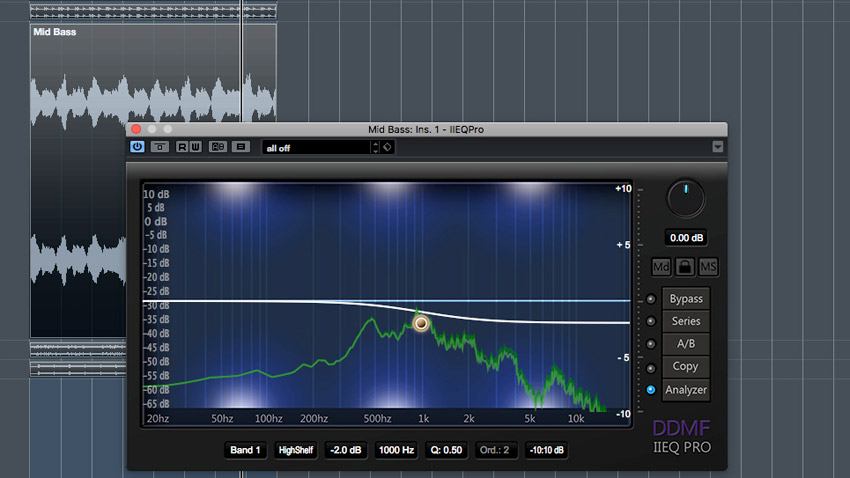Balance the bass: 8 sure-fire fixes to get your low-end properly parked
Top techniques to tame that bassline

Often, the most challenging stage of the bass design process is slotting your finished synth or electric/acoustic bass sound into the mix so that it can be heard in its intended entirety without overwhelming other parts in the same frequency range - or, indeed, others.
Basslines being the attention-drawing, potentially mix-overwhelming things that they are, the ability to balance them accurately and 'correctly' is a key skill that every producer needs to develop. Get yourself on the right track with this collection of tips.

1. Forget the filter
If your sub bass isn’t hitting hard enough, try removing any high-pass filtering. As most sub basses are synthesised from a pure sine wave, a filter is often unnecessary; and even with a gentle 20Hz roll-off, the filter curve will also affect the frequencies directly above the cutoff point, giving a more hollow sound. Try using a low EQ shelf to tame subs instead.
2. Adding presence
Struggling to get the detail in a bass guitar recording to shine through a busy mix? Why not try adding a healthy slug of EQ at around 1kHz? This’ll bring out the upper harmonics and help the listener’s ear decipher the bass more clearly. To accentuate the effect, try taking some broad 1-2dB EQ cuts at about 1kHz out of the guitars or drum overheads to give your bass EQ boost more room to breathe.
3. Synth saturation
Beefing up an overly clean synth bass with saturation is a widely employed tactic for adding warmth and depth to ITB mixes, but a cleaner yet equally dense end result can be achieved by adding the saturation on an FX send rather than applying it to the whole sound. This lets you saturate the dry sound to taste in parallel, without excessively distorting the dry signal.
4. Keep it rolling
When mixing dance music tracks based on a drop, you can make the bass sound even more impressive by automating a subtle high-pass filter on the music, vocals and atmospherics to switch on when the full track drops. This enables you to keep some low-frequency energy in the intro (to stop it sounding too thin), while still leaving room for bone-crushing bass at the key moment in the track.

5. On the shelf
Complex, distorted bass synth patches such as those in DnB and dubstep naturally contain a lot of upper harmonics in the mids and highs. These frequencies can easily clash with your percussion tracks and other instruments in the mix, so try taking a small 1-2dB high shelf dip out of your bass synth at 1kHz. Even if the mix doesn’t sound obviously noisy in the higher frequencies, you’ll be surprised by the added clarity this can provide.
Want all the hottest music and gear news, reviews, deals, features and more, direct to your inbox? Sign up here.
6. Inside the ride
If you’ve strapped a compressor over your bass to even the dynamics out, but the jump in volume between notes is still too noticeable or unwanted, try editing the notes manually using volume automation and ride levels before compression. This will typically give a more even, less obviously-compressed overall sound that feels gelled together without unwanted artefacts. Conversely, making certain bass notes louder can be a great creative effect if you want the bass to sound like it’s jumping out of the speakers at certain points. Listen in the context of the mix and decide for yourself.

7. Peter pan
A neat trick for giving the centre of your stereo mix some extra separation is to pan the bass out to one side by just a few degrees. This will slightly shift it from the centre of the mix without imposing any serious phase cancellation penalties when the mix is heard in mono. This one’s not only a winner when mixing densely-layered rock music, but also well worth trying in electronic mixes.
8. Sub driver
Sometimes, the weight of a bassline’s sub frequencies can overwork a compressor, leading to a distorted, ‘wooly’ sound that lacks punch. An easy solution to this common problem is to use a compressor with a high-pass filter in its sidechain detection circuit to prevent the compressor being triggered by any frequencies below the sidechain filter’s frequency. This is a great move for compressing live recordings of upright or electric bass that contain variable dynamics in the first, second and third harmonics.
Computer Music magazine is the world’s best selling publication dedicated solely to making great music with your Mac or PC computer. Each issue it brings its lucky readers the best in cutting-edge tutorials, need-to-know, expert software reviews and even all the tools you actually need to make great music today, courtesy of our legendary CM Plugin Suite.
